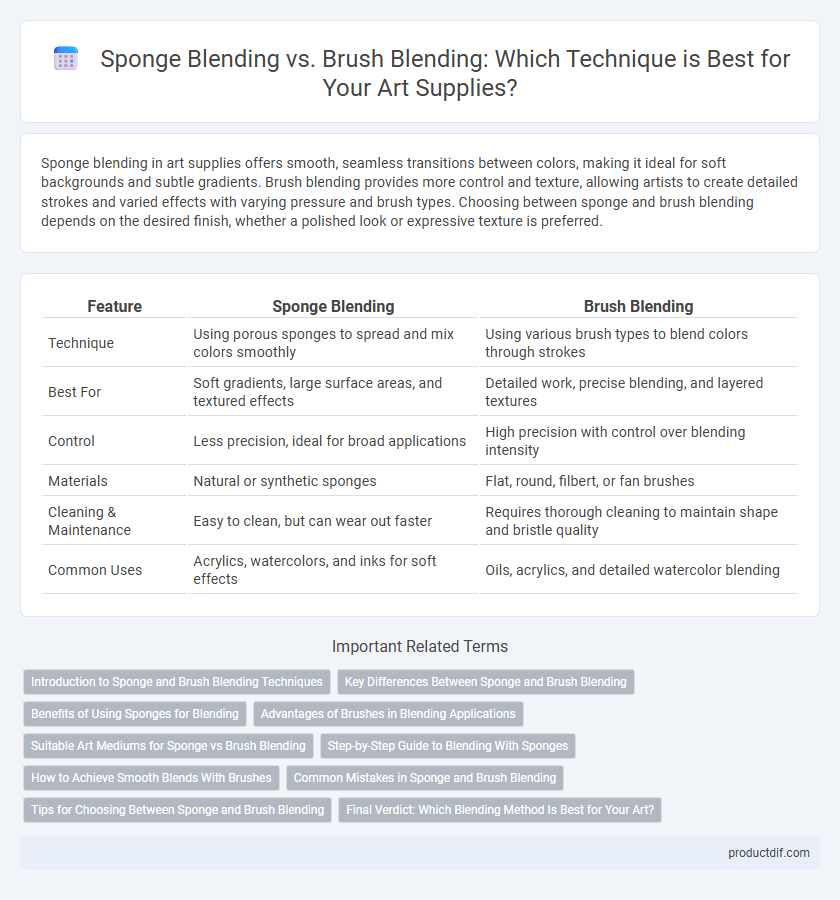Sponge blending in art supplies offers smooth, seamless transitions between colors, making it ideal for soft backgrounds and subtle gradients. Brush blending provides more control and texture, allowing artists to create detailed strokes and varied effects with varying pressure and brush types. Choosing between sponge and brush blending depends on the desired finish, whether a polished look or expressive texture is preferred.
Table of Comparison
| Feature | Sponge Blending | Brush Blending |
|---|---|---|
| Technique | Using porous sponges to spread and mix colors smoothly | Using various brush types to blend colors through strokes |
| Best For | Soft gradients, large surface areas, and textured effects | Detailed work, precise blending, and layered textures |
| Control | Less precision, ideal for broad applications | High precision with control over blending intensity |
| Materials | Natural or synthetic sponges | Flat, round, filbert, or fan brushes |
| Cleaning & Maintenance | Easy to clean, but can wear out faster | Requires thorough cleaning to maintain shape and bristle quality |
| Common Uses | Acrylics, watercolors, and inks for soft effects | Oils, acrylics, and detailed watercolor blending |
Introduction to Sponge and Brush Blending Techniques
Sponge blending involves using soft, porous materials to apply and diffuse pigments smoothly, creating seamless gradients ideal for watercolor and acrylic paints. Brush blending utilizes different brush types and strokes to mix colors directly on canvas, offering precise control over texture and detail in oil and acrylic media. Both techniques enhance artistic expression by providing distinct effects suited to various painting styles and mediums.
Key Differences Between Sponge and Brush Blending
Sponge blending offers smooth, even application ideal for creating soft gradients and textured effects, whereas brush blending provides precise control and detail suitable for fine lines and intricate designs. Sponges absorb more paint, allowing for quicker coverage but less control, while brushes retain bristles' flexibility to manipulate paint thickness and layering. The choice between sponge and brush blending depends on the desired outcome, surface texture, and level of detail in the artwork.
Benefits of Using Sponges for Blending
Sponges offer superior texture control and seamless gradient effects in art supply blending, making them ideal for creating smooth transitions and soft edges. Their porous surface absorbs and distributes pigment evenly, reducing the risk of streaks and harsh lines that brushes can sometimes leave. Artists benefit from the ease of dabbing and pressing techniques with sponges, achieving unique textures and a natural, organic feel in their artwork.
Advantages of Brushes in Blending Applications
Brushes provide superior control and precision in blending applications, allowing artists to create smooth gradients and intricate textures with ease. Their varied shapes and bristle types offer versatility, making them ideal for delicate transitions and detailed work. Unlike sponges, brushes enable artists to adjust pressure and direction, enhancing the blending quality and achieving more refined effects.
Suitable Art Mediums for Sponge vs Brush Blending
Sponge blending excels with acrylics, watercolors, and inks, offering smooth gradients and textured effects ideal for porous papers and canvas. Brush blending suits oil paints, gouache, and thick acrylics, providing precise control and seamless color transitions mostly on primed canvas or heavy watercolor paper. Selecting the right tool enhances medium performance, with sponges favoring absorption and texture, while brushes deliver detail and fluidity.
Step-by-Step Guide to Blending With Sponges
Sponge blending in art supplies offers a unique texture and smooth gradient effect compared to brush blending, ideal for creating soft backgrounds and seamless color transitions. Begin by dabbing a clean, damp sponge into your chosen paint or ink, then gently apply it to the surface in a stippling motion for even coverage. Gradually layer colors by blending edges with light circular motions, allowing controlled mixing without harsh brush strokes.
How to Achieve Smooth Blends With Brushes
Achieving smooth blends with brushes in art requires using soft, clean brushes and light, circular strokes to gently mix colors on the canvas. Layering thin glazes of paint while maintaining a slightly damp brush enhances seamless transitions between hues. Selecting high-quality synthetic or natural brushes with fine bristles maximizes control and precision, resulting in flawless gradient effects.
Common Mistakes in Sponge and Brush Blending
Common mistakes in sponge blending include over-saturating the sponge with paint, leading to uneven application and patchy textures, as well as using a low-quality sponge that can disrupt smooth transitions. In brush blending, errors often arise from insufficient brush cleaning between colors, causing muddy mixtures, and applying excessive pressure that damages bristle integrity and reduces blending softness. Mastery of these techniques requires selecting appropriate tools and maintaining proper paint consistency to achieve seamless gradients in artworks.
Tips for Choosing Between Sponge and Brush Blending
Sponge blending offers smooth, even coverage ideal for soft gradients and texture-free surfaces, while brush blending provides precise control and is better suited for detailed work and layering colors. When choosing between sponge and brush blending, consider the medium you're using--sponges excel with inks and watercolors, whereas brushes perform well with acrylics and oils. Evaluate your project's desired texture and level of detail to select the most effective blending tool for professional-quality art supply results.
Final Verdict: Which Blending Method Is Best for Your Art?
Sponge blending offers smooth, even coverage ideal for soft gradients and textured effects, while brush blending provides more precision and control for detailed work and layering. Artists seeking quick, seamless transitions may prefer sponges, whereas those aiming for intricate blending and brushstroke variety often choose brushes. Selecting the best blending method depends on the desired texture, detail, and overall style of the artwork.
Sponge blending vs Brush blending Infographic

 productdif.com
productdif.com